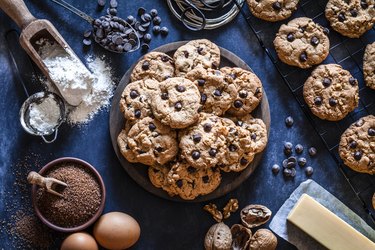
If you're indulging in a delicious cookie, the last thing you want is a soft top and burned bottom. No one likes when cookies are too brown on the bottom. Some simple hacks prevent burned cookies, and make for a delicious batch every time.
Prevent Burned Cookies
Video of the Day
Several steps in the cooking process can help prevent burned cookies. For example, while you want to use butter in the batter, using butter or nonstick spray to grease your pan can cause over-browning.
Video of the Day
Usually cookies have enough fat in them to not stick. If you're concerned about sticking, use parchment paper to line the pan, as it won't promote over-browning. Parchment paper also makes it so sticky ingredients don't make a mess of your pan; it guarantees easy clean up.
Speaking of the baking pan, use a lighter grey or reflective aluminum cookie sheet. When you cook on darker colored pans, you get cookies that are too brown on the bottom. The dark pans absorb heat, and are more likely to result in burned baked goods.
Always place your baking sheet in an oven rack position that's in the middle of the oven. This promotes optimal circulation of heat. Set your oven at about 360 degrees Fahrenheit. K-State Research & Extension note that this is the optimal temperature for caramelizing the top, to reach a nice tan color.
Place only one baking sheet in the oven at a time, too. It may take longer to bake all of your batter, but multiple sheets alter how air flows around your cookies. As a result, cookies on the bottom may brown too much while the ones on top don't cook through.
Be conservative with the timer. Check your cookies a few minutes before the recipe says they'll be done. A finished cookie has a dull shine, but is lightly golden-brown around the edges. The batter should look set, too.
Checking early prevents overcooking, especially on the bottom. If you find they need more cook time, leave them for an extra minute or two, and then check again.
Be a Smart Cookie
Burning your cookies is only one of your concerns when making homemade cookies. Good food handling procedures and smart, healthy eating habits are also important.
When prepping your perfectly-baked cookies, do not sample the raw batter, warns the Centers for Disease Control and Prevention. Raw doughs, especially those that contain eggs or flour, can contain bacteria that causes foodborne illness. If you really want to skip the baking process, try our No-Bake Honey Peanut Butter Cookies.
When you do indulge in sweet baked goods, such as cookies — homemade or not — make them a sometimes food. A small 2 1/4-inch chocolate chip cookie prepared at home, from a recipe, contains about 78 calories.
Read more: 10 Desserts That Won't Derail Your Diet
While it's perfectly fine to enjoy a treat now and then, cookies and other foods with added sugars should be just that — a treat. The USDA Choose My Plate guidelines suggest you choose foods with lower amounts of added sugar. These 5-ingredient Oatmeal Raisin Cookies from LIVESTRONG.com may be a good choice.
If you do have a cookie, make it only an occasional dessert or snack choice. When you crave a sweet treat, opt for fresh fruit, applesauce or even small portions of no-sugar-added dried fruit, at least most of the time. While cookies aren't off limits, they shouldn't be an everyday food.